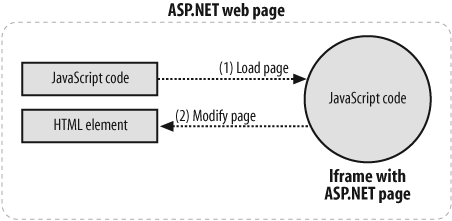Pure JavaScript
To conclude this chapter, it should also be mentioned that you do not even need Ajax to create Ajax-like effects. Or, to be more technically accurate, you do not need XMLHttpRequest to exchange data with the server. Using a bit of HTML knowledge and adding a bit of JavaScript to the mix, you can avoid the complexity of the various frameworks and just rely on your scripting knowledge.
The idea is to use a hidden frame to load another file in the browser, but in a way that the user does not see it. This new file contains JavaScript code that is created on the server and can therefore access server-side information. This code then changes some elements on the original page. This asynchronous approach has been quite common for several years, but without a fancy name like Ajax. This method avoids some of the browser incompatibility problems that made it so painful to create browser-agnostic web sites.
Figure 16-5 shows the concept: the code is loaded in either a hidden frame (<frame> element) or in an invisible iframe (<iframe> element). The latter option is preferable, because iframes can be embedded into a page. Then, the code in the iframe can change other HTML elements on the page.

Figure 16-5. Emulating Ajax without XMLHttpRequest
First of all, an invisible iframe is required:
<iframe name="calculator" style="display: none;"></iframe>
As you can see, the iframe is ...
Get Programming Atlas now with the O’Reilly learning platform.
O’Reilly members experience books, live events, courses curated by job role, and more from O’Reilly and nearly 200 top publishers.

